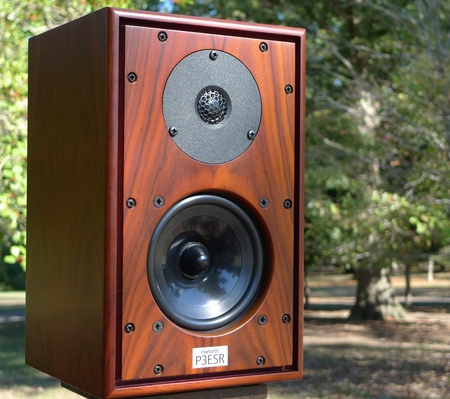by: Steve Guttenberg / The Audiophiliac

Nothing gets older faster than high-tech, but the Harbeth P3ESR sounds so good you may never want to replace it with another speaker. That’s no hype; I know audiophiles still using similar speakers originally manufactured in the 1970s.
That’s when American audiophiles first fell in love with small British monitor speakers engineered and designed by the British Broadcasting Corporation (BBC), and manufactured by a number of companies, including KEF, Goodmans, Rogers, Spendor, and Harbeth. Though the speakers were all built around the same design, known as the LS3/5A, not all LS3/5As sounded exactly the same. Back in those days those British companies built all of their speakers in the home country, but that’s no longer true for current British brands like Bowers & Wilkins, KEF, Linn, Monitor Audio, Quad, or Wharfedale. Harbeth is one of the few bucking the outsourcing trend; it still designs and builds all of its speakers in house.
I owned a pair of Rogers LS3/5As back in the day, and truth be told, I never understood the monitor moniker. The speakers didn’t sound particularly accurate or revealing of recordings’ flaws, which is what you would expect from a studio monitor. The speakers made most recordings sound nicer than they really were, which is why 30-year-old LS3/5As are still sought after.
Harbeth’s terrific P3ESR is a contemporary equivalent of the LS3/5A. The 12-inch-high speaker feels remarkably solid, and the lovely (real) wood veneer is impeccable. The front baffle hosts a Harbeth-made 5-inch woofer and a 0.75-inch tweeter. Like the LS3/5A, the P3ESR doesn’t have a bass port; it’s a sealed box design.
Little speakers can sound small and restrict dynamic range compared with what you get from tower speakers, so it came as no surprise that the P3ESR can’t rock out, or fill a big room with lease-breaking volume. If that’s what you want, the P3ESR won’t satisfy. Taken down to a more moderate volume with acoustic music, the P3ESR is a very credible performer. There’s a freewheeling quality to the P3ESR’s sound that I find irresistible. Voices and instruments sound more completely present and full-bodied than they do with many speakers, even bigger and more expensive ones. Rocking out to ZZ Top is definitely doable, but not to the point that your hearing will be in danger. Deep bass isn’t part of the deal, but the P3ESR can dish out satisfying bass without the assistance of a subwoofer. This might be the ideal audiophile speaker for small apartments, and office or bedroom hi-fis. It also sounded spectacular on my desktop, powered by my 30-year-old NAD 3020 integrated amplifier. I didn’t have a LS3/5A on hand to do a direct comparison, but I think the P3ESR is a better, more dynamic, higher-resolution device than a LS3/5A.
The P3ESR, in real cherry wood, is expensive ($2,095 a pair), but it’s the sort of speaker that you might enjoy for many decades to come. I wrote an in-depth P3ESR review for Inner Fidelity in May. Decades-old LS3/5A speakers on eBay aren’t more affordable than brand-new Harbeth P3ESRs, which perfectly demonstrates the fact that some great speakers are terrific long-term investments.
